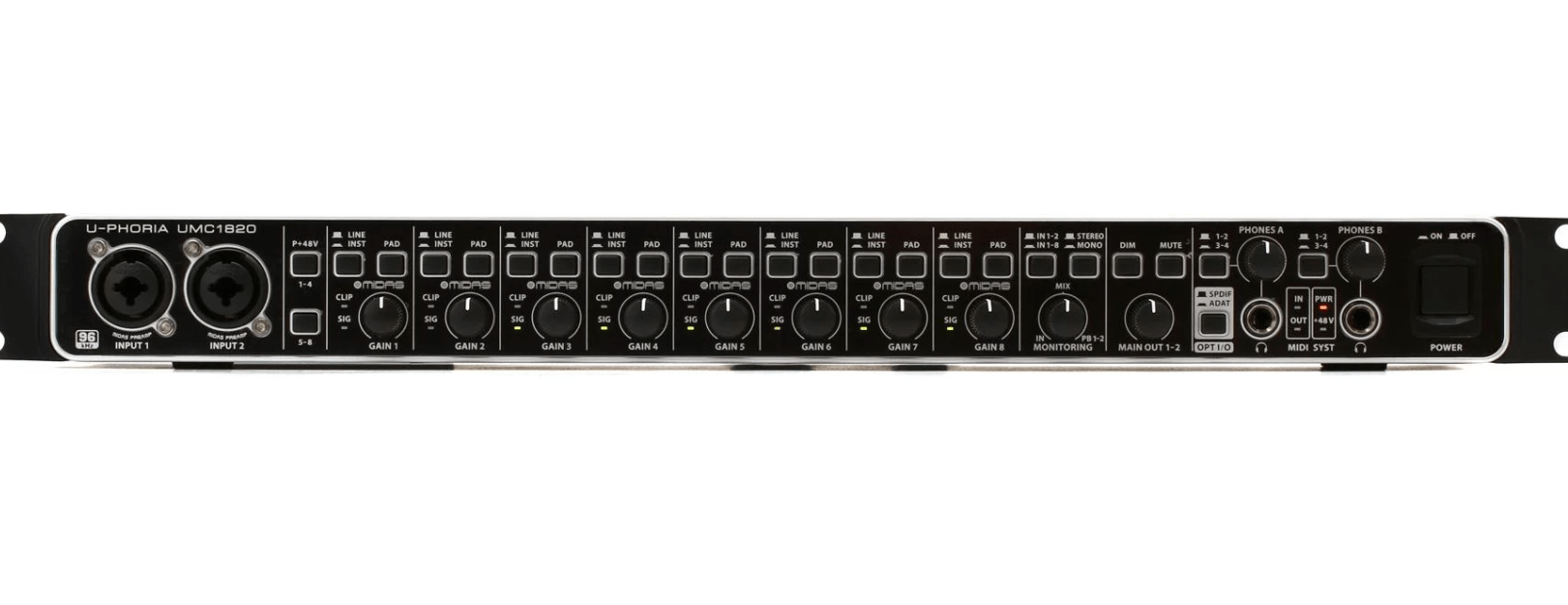Table of Contents
We were excited to look at the Behringer U Phoria UMC 1820. Having previously reviewed the entry-level model of the U Phoria line, and concluded that the preamps are superb but the I/O limited, we found that this a much larger piece of kit that provides a more extensive I/O selection. This makes it a more flexible option for anyone looking to record multiple sources simultaneously.
When it comes to drumkits, you're always going to need at least three, if not more, mic inputs. Today's basic 2-in 2-out plug and play style studio interfaces aren't equipped to handle the drums professionally. Sure, you might get a couple of overheads, but your bass won't have the prominence it deserves to drive a track.
The Behringer UMC 1820 features a robust, industry-level build with left and right ears. It's perfect for mounting into an existing system. It's 17 inches wide and takes up a rack space of 1U. It has an impact-resistant, all-metal chassis to keep it well protected.
All of the controls are front-mounted for easy access. The first and second channel inputs facing you make using this model less-complex and recording tasks a little simpler. You will find the rest of the input channels on the rear panel with the outputs. This design decision keeps it slim and uncluttered, despite there being a lot of integrated hardware.
This interface features eight built-in analog inputs, all of which are combo style MIDAS preamps. You can switch between the instrument and line-in with the touch of a button. Each input comes with a gain dial and a small clipping indicator to help you set your levels.
They all have access to 48-volt phantom powering, divided up into two groups of four, so you half your inputs can be dedicated to mic use and the rest for guitars. Every channel also has a 20decibel pad, which is not something you typically have on offer for every single channel. Many units retailing in this price region only offer an attenuation of 10 decibels.
This means that you can use any inputs with high-gain instruments, handling hot pickups with pro-level efficiency. When the pad button is engaged, any potential signal distortion risks will be squashed as the unit attenuates for you.
The well-engineered MIDAS preamps are some of the most reputable on the market. They work with professional resolution converters (24-bit/96kHz) to ensure signal capture is as accurate as possible. This gives you digital data that's true to the original input, without any noise or coloration.
In addition to the analog inputs, it features an S/PDIF and an ADAT input that allows you to expand the inputs to a total of 18. This lets it cater for a wide range of practical recording set-ups.
On the right-hand side of the front panel, you will find two monitoring clusters of controls. Having dual headphone outputs means you can monitor two different output sources and use it for DJ cueing. The monitoring is zero latency, so you won't have any lag issues.
There are 10 TRS outputs, an S/PDIF, and an ADAT out as well as MIDI in and out, giving a versatile range to choose from. There are 20 output options in total with the ADAT hookup added into the mix.
Behringer U Phoria Umc1820

Summary
The Behringer UMC 1820 is a very capable piece of tech. It's equipped with all the connections to expand it into an 18-in 20-out channel box. Each analog channel has phantom power on hand and a 20 dB pad.
It has a well-thought-out design and is built like a brick house, as well as sporting an impact-resistant chassis that will mount easily into a professional rig.
The preamps are of high quality, and the sound comes with a professional conversion resolution. It copes efficiently with high-gain instruments and offers a lot of flexibility in terms of outputs. With RCA connections and zero-latency dual headphone monitoring, it can be used to live cue.
All in all, this is an excellent piece of kit that offers a range of features that are usually found on units priced far higher.
Pros
+ Hardy casing with ears.
+ Sensible layout.
+ 18 inputs (utilizing ADAT connection).
+ 20 outputs on offer.
+ Great mix of analog and digital I/O.
+ Independent gain control.
+ Grouped phantom powering.
+ 20dB cut-off pad for each channel.
+ Hi-Res converters.
+ MIDI I/O.
+ Dual headphone A/B monitoring.
+ USB 2.0 computer connectivity.
Cons
- It's class-compliant, which is great. But this does mean it will require a driver for windows set-up if you want to connect it to your PC.
Why We Like It
It's so well equipped, there probably isn't a studio set-up it couldn't handle. If you're looking for something with ADAT expansion that won't break the bank, then you can't go wrong.
The MIDAS preamps have earned a good rep in a short time. We love that the pads and phantom power options haven't been limited to tracks one and two - a design decision that many other companies opt for.
If you liked the article, please leave your feedback.
